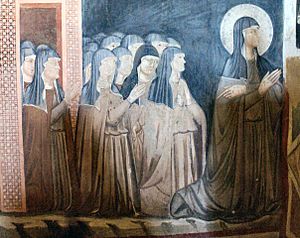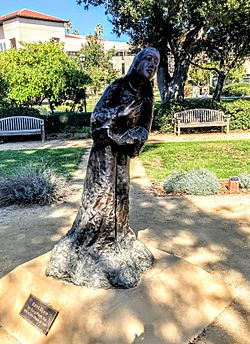Clare of Assisi facts for kids
Quick facts for kids SaintClare of Assisi OSC |
|
|---|---|
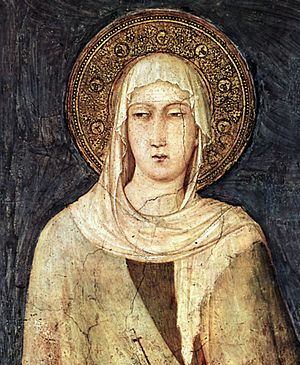
Detail depicting Saint Clare from a fresco (c. 1320) by Simone Martini in the Lower basilica of San Francesco, Assisi
|
|
| Virgin | |
| Born | Chiara Offreduccio 16 July 1194 Assisi, Duchy of Spoleto, Holy Roman Empire |
| Died | 11 August 1253 (aged 59) Assisi, Papal States |
| Venerated in | Roman Catholic Church, Anglican Communion, Lutheran Church |
| Canonized | 26 September 1255, Rome by Pope Alexander IV |
| Major shrine | Basilica of Saint Clare, Assisi |
| Feast | 11 August (1970 to date) |
| Attributes | Monstrance, pyx, lamp, habit of the Poor Clares |
| Patronage | Eye disease, goldsmiths, laundry, television, bicycle messengers, good weather, needleworkers, remote viewing, extrasensory perception; Santa Clara, California; Santa Clara Pueblo, New Mexico; Obando, Bulacan, Philippines |
Clare of Assisi (born Chiara Offreduccio, 16 July 1194 – 11 August 1253) was an Italian saint. She was one of the first followers of Francis of Assisi. Clare started a religious order for women called the Order of Poor Ladies. This group followed the Franciscan way of life.
Clare also wrote their "Rule of Life." This was a set of guidelines for how the nuns should live. It was the first time a woman was known to have written such rules for a religious order. After she died, the order was renamed the Order of Saint Clare. Today, they are commonly known as the Poor Clares. Her special day, or feast day, is celebrated on 11 August.
Clare's Life
Clare was born in Assisi, Italy, in 1194. Her family, the Offreduccios, was wealthy and important. Her father was a count, and her mother, Ortolana, was a very religious woman. Ortolana had traveled to many holy places. Later, Clare's mother and her sisters, Beatrix and Catarina (who became Saint Agnes), joined Clare's monastery.
As a child, Clare loved to pray. When she was a teenager, she heard Francis of Assisi preach. Francis talked about living a simple life, following the teachings of the Gospel. Clare was inspired and asked him to help her live this way too.
On the evening of Palm Sunday in 1212, Clare left her family home. She went to a small chapel called the Porziuncula to meet Francis. There, she cut her long hair. She traded her fancy clothes for a simple robe and a veil. This showed her commitment to a new, humble life.
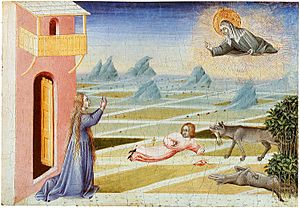
Francis first placed Clare with some Benedictine nuns nearby. Her father tried to make her come home. But Clare held onto the church altar and showed her short hair. She refused to leave, saying she would only be devoted to Jesus Christ.
A few days later, Francis moved her to another Benedictine monastery for more quiet. Soon, her sister Catarina joined her and took the name Agnes. They stayed there until a small home was built for them. This home was next to the church of San Damiano, Assisi, which Francis had fixed earlier.
Other women soon joined Clare and Agnes. They became known as the "Poor Ladies of San Damiano." They lived a very simple life. They chose poverty, strict rules, and stayed away from the outside world. Francis gave them a special set of rules to follow. This group became the "Second Order" of Franciscans, now known as the Poor Clares.
San Damiano became the main place for Clare's new religious group. It was the first house of their order. In 1228, a church leader offered Clare a way to avoid their strict vow of poverty. But Clare refused. She said she needed to be forgiven for her sins, not for following Christ. So, the Pope allowed them to keep their special vow of poverty. This meant no one could force them to own anything.
Unlike the Franciscan friars, who traveled to preach, Clare's sisters lived in enclosure. This meant they stayed within their monastery walls. Their daily life included manual work and prayer. The nuns walked barefoot, slept on the ground, and did not eat meat. They also kept almost complete silence.
In 1216, Clare became the abbess of San Damiano. This gave her more power to lead her order. She protected her order from leaders who wanted them to follow less strict rules. Clare wanted to be like Francis, so much so that some called her "another Francis." She also supported Francis and cared for him when he was sick.
After Francis died, Clare continued to help her order grow. She wrote letters to other abbesses in Europe. She also stopped popes from changing her order's rules. She wanted to keep their strong commitment to poverty. Clare's ideas about joyful poverty, following Christ, are clear in her rules and letters.
In 1240 and 1241, armies attacked the monastery of San Damiano and the town of Assisi. Clare prayed to Christ, who was present in the Blessed Sacrament (a special bread used in church). Both the monastery and the town were successfully defended.
In her later years, Clare was often sick. She died on 11 August 1253, at 59 years old. Her last words were said to be, "Blessed be You, O God, for having created me."
After Her Death
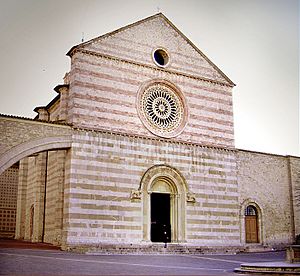
Just two days before Clare died, the Pope approved her rules for the Order of Poor Ladies. Her body was first buried in a chapel. A new church was then built to hold her remains. At her funeral, the Pope asked for a special service for saints, not for the dead. This showed that the process to make her a saint would begin soon.
The process to make Clare a saint started right away. It took two years in total. On 26 September 1255, Pope Alexander IV officially declared Clare a saint. She became Saint Clare of Assisi.
The Basilica of Saint Clare was finished in 1260. On 3 October of that year, Clare's body was moved to the new basilica. She was buried under the main altar. In 1263, the Pope officially changed the name of her order to the Order of Saint Clare.
About 600 years later, in 1872, Clare's relics (her remains) were moved again. They were placed in a new shrine in the crypt of the Basilica of Saint Clare. You can still visit them there today.
Clare's Legacy
Clare was made a saint on 26 September 1255. Her feast day was first celebrated on 12 August. Later, in 1969, the church calendar was changed. Her feast day was then moved to 11 August, the day she died.
The Basilica di Santa Chiara began to be built a year after Clare became a saint. Her remains were moved there in 1260. Her bones were found again in 1850 and are now in the crypt of the Basilica.
In art, you often see Clare holding a monstrance or a pyx. These are special containers used in church. This shows a famous story about her. When soldiers attacked her convent, she held up the Blessed Sacrament and prayed. The soldiers then left.
Pope Pius XII named Clare the patron saint of television in 1958. This was because when she was too sick to go to church, she reportedly saw and heard the Mass on the wall of her room.
There is a tradition of bringing eggs to the Poor Clares to ask for good weather, especially for weddings. This is popular in the Philippines. The tradition comes from Clare's name. In Spanish, "clara" can mean clear weather or the white part of an egg.
Many places are named after Saint Clare. These include churches, convents, schools, hospitals, towns, and counties. Lake St. Clair between Lake Erie and Michigan was named after her in 1679. The St. Clair River and other places nearby also got their names from her.
Mission Santa Clara de Asís, founded in California in 1777, gave its name to many places. These include Santa Clara University, the city of Santa Clara, and Santa Clara County. This area is now known as "Silicon Valley." The Santa Clara River in Southern California is also named after her. Early Spanish missionaries, who were Franciscans, greatly admired Saint Clare.
The first convent in Cuba was named Convento de Santa Clara de Asis. The city of Santa Clara, Cuba and its cathedral are also named after her. Even one of Christopher Columbus's ships, the Niña, was officially named Santa Clara.
Clare of Assisi is remembered in the Church of England and other Anglican churches. They celebrate a special day for her on 11 August.
See also
 In Spanish: Clara de Asís para niños
In Spanish: Clara de Asís para niños
- Saint Clare of Assisi, patron saint archive


